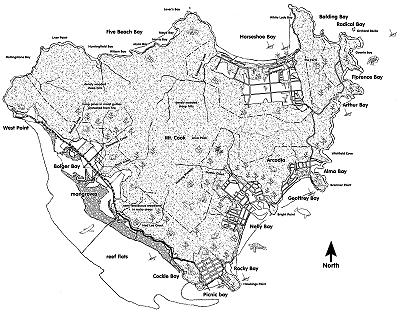Island Overview - Vegetation & Landscape

Island Overview - Vegetation & Landscape
High Resolution map (1.4MB! .pdf)
The outstanding universal values of Magnetic Island are not just limited to the World Heritage fringing reefs but also include the island itself as a continental island within the Great Barrier Reef World Heritage Area (GBRWHA), these outstanding universal values include its geology, flora & fauna.
The island has a unique place in the GBRWHA as the most northern outlying continental island of the dry tropics floristic region. Its' close proximity to the Wet Tropics World Heritage Area, affords a greater diversity of habitat types. Indeed the island along with its' dry tropical habitats, even includes pockets of true rainforest as well as remnants of earlier Gondwanan flora such as the hoop pine (Araucaria cunninghamii), evidence of wetter times, which indicates a more widespread rainforest flora prior to eucalyptus expansion some 8-9000 years ago.
Weathered Hoop Pines (Araucaria cunninghamii) wedged amongst headland boulders are the year round signature of Magnetic Island. In sheltered locations such as hillside gullies. Hoop Pines achieve a symmetrical architecture. Island Hoop Pines only grow in areas protected from fire and at altitudes below 200 metres.
Native Kapok (Cochlospermum gillivraei) is common on the lower rocky slopes. The edible brilliant yellow flowers appear in August when the tree is leafless and are the winter signature of the Island. The flowers are followed by "cotton wool" seedpods in December. Early European settlers on the island used the seedpod fibre to stuff pillows.
The Island settlements are remarkable for the amount of native vegetation they retain. The main tree species in the settlements are eucalypts reflecting an Australian bushland character as well as habitat for wildlife. The sandy lowlands, (which include coastal plains and older sand dunes), of the island contain extensive areas of tropical poplar gum and bloodwood woodlands and are intersected by creeks fringed with communities of weeping paperbark and blue gums. There is a good example of the remnant creek vegetation systems at the western end of Horseshoe Bay. Eucalyptus woodlands dominate the vegetation of the higher hilly areas of the Island, with semi-deciduous vine thickets in sheltered areas and on lower rocky country, as well as wattle shrublands on shallower soils.
Rocky headlands protect the numerous sandy bays on the island. On the northern and south-eastern sides of the island strong wave action has resulted in a seaward fringe of sand dunes backed by a sandy coastal plain. On the sheltered western side of the island, the coastal plain is traversed by numerous flood plains consisting of decomposed granite.
There are two seasonal freshwater lagoons on the island, one on each side, where abundant bird life can be seen for most of the year. Estuarine wetlands are present at the western end of Horseshoe bay with a more extensive system of estuarine and marine wetlands occur throughout the sheltered western side of the island.
All the bays of the island are traversed by seasonal creeks, the largest being Gustav Creek in Nelly Bay. These creeks provide sediment from the hills to nourish the beaches, while the vegetation affords protection and an area of refuge for wildlife well into the dry season. Historically Gustav Creek was mapped as savanna woodland and grassland, with a reduction of fire since European settlement, the vegetation has since changed to pockets of rainforest.
The marine habitats of the island are extensive. Tidal flats are common with salt-water couch grasslands on the higher landward margins, and saltpan and mangrove communities on the seaward of these. Offshore are diverse tidal mudflats, marine grass beds and coral reef.
Fore more information on the natural values of magnetic island a comprehensive interpretative facility can be found in the Nelly Bay Habitat Reserve, there is also numerous "Landscape Ecology" and "Flora & Fauna" signs scattered throughout the islands towns and bays. |